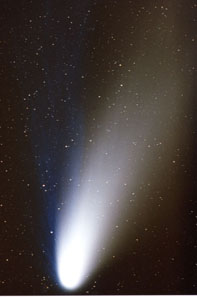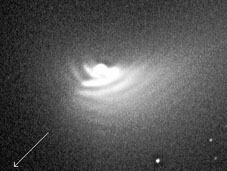Articles
The Tunguska event ... Chris Trayner
The Tunguska event of 1908 is reviewed. The event, its location, effects, eye-witness reports, apparent trajectory and probable nature are described. The importance and growing availability of Russian research are mentioned. It is concluded that the event was probably caused by the collision of a comet or asteroid with the Earth, but that it is not yet certain which. (pp. 117-130)
Visual and photographic observations of the Perseid meteor shower in 1994 ... N. M. Bone & S. J. Evans
The Perseids of 1994 continued the recent pattern of a double maximum, with a novel, higher activity peak occurring at 11h UT on the morning of August 12 at solar longitude(2000.0) = 135°.59, some 10-12 hours ahead of the expected regular maximum. The novel peak occurred over the western United States, whilst the bulk of BAA observers, in western Europe, were able to follow activity around the regular maximum, which occurred in the morning hours of August 12-13. Corrected Perseid Zenithal Hourly Rates in the two peaks reached levels in excess of 200, and up to 80, respectively - much as in 1993. (pp. 131-135)
The periods of Mu Cephei ... Tristram Brelstaff, Chris Lloyd, Tony Markham & Dave McAdam
Period analysis of BAA-VSS and JAS/SPA observations of Mu Cephei shows that two main periods of 850 and 4400 days were present during the years 1959-1993. This result is in good agreement with periods found in earlier data. It is likely that the 730-day period given in the GCVS and that of 920 days found in subsets of the data are aliases of the 850-day period. (pp. 135-140)
Johann Schroeter's 'Extremely Dark Spots of Jupiter' ... Thomas Dobbins & William Sheehan
Physical observations of Jupiter from the 18th century are rare. The most diligent observer of the planet of that era was Johann Schroeter, who in 1785-86 recorded multiple short-term, transient dark spots. Schroeter's observations are discussed in detail. Though somewhat reminiscent of the recent Shoemaker-Levy 9 impact events, the authors conclude that Schroeter's observations furnish a unique record of SEBn activity in the 18th century. (pp. 144-146))
The aurora 1995 ... R. J. Livesey
This report summarises observations of the aurora relating to the northern hemisphere collected in 1995 by members and correspondents of the Aurora Section. (pp. 156-161)
A photographic and mathematical method for recording and identifying lines in a solar spectrogram ... Jack Martin & Martin Peston
This paper is an introduction to Spectroscopy, an area of astronomy largely untapped by amateurs, yet playing a vital part in our understanding of the composition of the universe. It is also intended to serve as a guide to the amateur, on how to produce a spectrogram, extrapolate the data, work out the wavelengths and identify the corresponding elements that are present. Without the spectroscope, our knowledge of the nature of the stars and the universe would be very limited indeed. (pp. 141-143)
(Copies of any of these articles may be requested from the BAA office.)


 Photograph of Comet Hale-Bopp taken on 1997 March 30 at 20.46 UT by Martin Mobberley. 10m, Kodak Pro Gold 400, Takahashi E-160 astrograph. For more pictures of this comet by BAA members, see the colour Observers' Forum in the June Journal.
Photograph of Comet Hale-Bopp taken on 1997 March 30 at 20.46 UT by Martin Mobberley. 10m, Kodak Pro Gold 400, Takahashi E-160 astrograph. For more pictures of this comet by BAA members, see the colour Observers' Forum in the June Journal.
 Telescopic observers have been fascinated by the visual appearance of Comet Hale-Bopp's inner coma, as spiral rings of dust are thrown off from the nucleus. This image is by Maurice Gavin on 1997 March 6 at 04.21 UT. The arrow shows the sunward direction. 2.5s., 300mm f/10 SCT with Starlight Xpress CCD. M. V. Gavin
Telescopic observers have been fascinated by the visual appearance of Comet Hale-Bopp's inner coma, as spiral rings of dust are thrown off from the nucleus. This image is by Maurice Gavin on 1997 March 6 at 04.21 UT. The arrow shows the sunward direction. 2.5s., 300mm f/10 SCT with Starlight Xpress CCD. M. V. Gavin